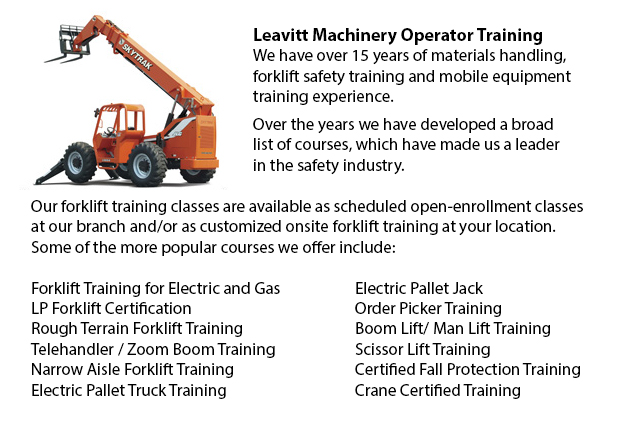
Nanaimo Telescopic Training - Telescopic Handlers are a type of forklift, normally known as telehandlers. This machinery has been increasing in popularity due to its versatility and its greater lift heights. It is normally preferred over the conventional masted counterbalance truck (rough and standard terrain). Whether used for transporting pallets within a warehouse or for transporting raw materials into the back of a dump truck, the telescopic forklift is a valuable tool. Accredited telescopic handler training is essential to guarantee the efficient and safe use of the unit.
The kinds of lift trucks have been designed to handle heavy stuff with a telescoping arm that extends into many segments similar to a telescope. The things to consider when choosing the right telescopic forklift are things like how the machine is going to be used and for how long. Required lift heights and work site terrain should be taken into account. Warranty, parts and cost are all factors involved in purchasing a telescopic forklift. If you are going to lease, you will want to compare terms, delivery costs and prices.
Telescopic forklifts come in various sizes. Size influences the amount of weight that can be loaded onto the lift, and the heights that can be attained safely. A small- to medium-sized telescopic forklift is ideal for transporting materials into the back of a pick-up truck. Lifting heavier materials up higher will require a bigger lift. Careful consideration of how the lift would be used helps ensures you will choose the best size for safety and stability.
Attachments are another consideration when choosing machines. Ask what attachments are available from the manufacturer. There are pallet attachments, bucket attachments as well as different attachments for specific reasons.
Work site terrain influences the selection of tires for the telehandler. Cushion tires are made of rubber all the way through, and are found on smaller units. Cushion tires are best for telehandlers being utilized inside a warehouse with a concrete floor. They provide durability and stability. Pneumatic tires are often on larger units utilized on varied, outdoor terrain where there could be rock, dirt, concrete and asphalt. They offer the best traction and articulation.
-
Nanaimo Boom Lift Certification
Nanaimo Boom Lift Certification - Using elevated work platforms allow for maintenance operations and work to be carried out at elevated work heights which were otherwise not reachable. Workers making use of scissor lifts and boom lifts can learn how... More -
Nanaimo Boom Lift Safety Training
Nanaimo Boom Lift Safey Training - Boom lifts are a kind of aerial lifting device or elevated work platform which are commonly used in industry, warehousing and construction. Boom lifts could be utilized in practically whichever environment because o... More -
Nanaimo Loader Operator Training
Nanaimo Loader Operator Training - Loader Operator Training - Forklift training is a prerequisite within North America and is intended to prevent workplace death and injuries. Lift truck training provides driver training intended for forklift operato... More -
Fall Protection Certification in Nanaimo
There are high numbers of injuries at work associated to falling and lots of fall-related deaths reported each and every year. Most of these instances might have been prevented with better training, better measures in place, and by properly equipping... More -
Nanaimo Crane Ticket
Nanaimo Crane Ticket - The modern version of a crane can be either complex or simple, and cranes vary based on their use. Mobile cranes, for example are rather simple. A telescopic boom or steel truss mounts its movable platform. A system of levers o... More -
Operator Safety Certification | Re-Qualification Certification | In-House Instructor Certification in Nanaimo
Lift trucks are used in practically all industrial construction sites and in warehouse operations and in boat yards. The reach feature of a forklift is a very important part utilized in several applications like when a shelving system is being used t... More -
Aerial Lift / Boom Lift / Man Lift / Scissor Lift Certification in Nanaimo
Scissor hoists are lift tables which lift up materials and individuals and supplies vertically. They are normally used in construction, commercial and industrial environments. A common use of scissor hoists is for lowering or lifting construction sup... More -
Crane / Overhead Crane / Self-Erect Crane / Truck Mounted Crane / Hydraulic Cranes Certification in Nanaimo
Bridge cranes or likewise called overhead cranes are a type of industrial material handling crane utilizing a line and hook apparatus that runs on a horizontal beam running along two widely separated rails. Several overhead cranes can be seen inside... More

Forklift Certification Nanaimo
TOLL FREE: 1-888-254-6157
Nanaimo, British Columbia
forkliftcertificationnanaimo.com
Email Us
About Us


